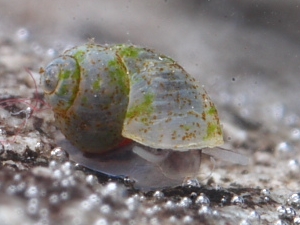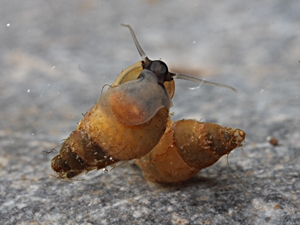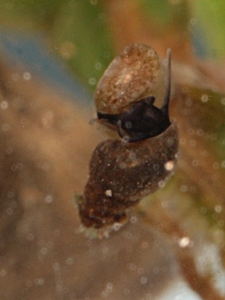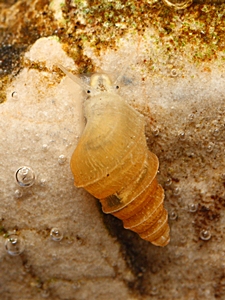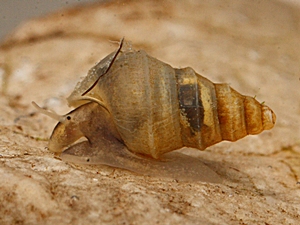Mud Snails (Hydrobiidae)
Spring snails are a very diverse family of small to tiny snails inhabiting
fre
sh or brackish water, also appearing on humid ground near the coast. Very few
species also actually are found in the sea, on muddy ground among seaweed. It is
estimated there are about 300 species in North and South Europe, about 1000
species worldwide, in Australia alone 280 species are mentioned. In Central
Europe many spring snail species inhabiting ground water, caves or springs are
limited to one single geographic finding site, which means a very large
ecological threat to those species.
 Systematics of Gastropoda: Clade Caenogastropoda: Hydrobiidae.
Systematics of Gastropoda: Clade Caenogastropoda: Hydrobiidae.
Mud Snails (Hydrobiinae)
Laver Spire Snail - Peringia ulvae (Pennant 1777).
 Laver spire snail (Peringia
ulvae).
Laver spire snail (Peringia
ulvae).
Spring Snails (Belgrandiinae)
Spring snails (Belgrandiella) in Austria
 Belgrandiella aulaei Haase,
Weigand & Haseke
2000
Belgrandiella aulaei Haase,
Weigand & Haseke
2000
 Belgrandiella austriana (Radoman
1975)
Belgrandiella austriana (Radoman
1975)
 Belgrandiella boetersi Reischütz
& Falkner 1998
Belgrandiella boetersi Reischütz
& Falkner 1998
 Belgrandiella fuchsi (Boeters
1970)
Belgrandiella fuchsi (Boeters
1970)
 Belgrandiella ganslmayri Haase
1993
Belgrandiella ganslmayri Haase
1993
 Belgrandiella kreisslorum Reischütz
1997
Belgrandiella kreisslorum Reischütz
1997
 Belgrandiella mimula Haase
1996
Belgrandiella mimula Haase
1996
 Belgrandiella multiformis Fischer
& Reischütz 1995
Belgrandiella multiformis Fischer
& Reischütz 1995
 Belgrandiella parreyssii (L. Pfeiffer
1841)
Belgrandiella parreyssii (L. Pfeiffer
1841)
 Belgrandiella pelerei Haase
1994
Belgrandiella pelerei Haase
1994
 Belgrandiella styriaca Stojaspal
1978
Belgrandiella styriaca Stojaspal
1978
 Belgrandiella wawrai Haase
1996
Belgrandiella wawrai Haase
1996
Source: Wolfgang Fischer:
Checklist of Austrian Mollusca.
Among the spring snails of the Belgrandiella genus there is also the thermal spring snail Belgrandiella pareyssii, which shares the
thermal springs of Bad Vöslau in Lower Austria with the
thermal spring nerite (Theodoxus prevostianus) and the
thermal spring pitch snail (Esperiana
daudebartii).
 Spring snails (Sadleriana) from Slovenia and Croatia.
Spring snails (Sadleriana) from Slovenia and Croatia.
Fountain Snails (Bythiospeum)
Fountain snails not only live in fountains. There are many cave-dwelling
species among them, as are species living in the ground water. Some attention
the snail Husmann's fountain snail received by being elected mollusc of the year
2009.
| |
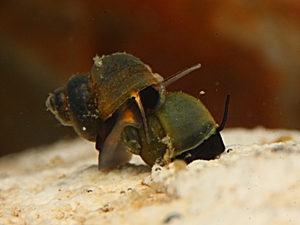
Another group of spring snails are the Sadleriana genus (this
is Sadleriana schmidtii from Slovenia).
Picture: © Alexander Mrkvicka, Vienna (mrkvicka.at). |
The snail with the scientific name
Bythiospeum husmanni at the current state of knowledge exclusively is to be
found in the ground water flow accompanying the river Ruhr in North
Rhine-Westphalia. It is only able to survive in extremely clean and constantly
cool ground water. Its appearance therefore also is valued as an indicator for
the innocuousness of this area's ground water as a resource for drinking water.
In the rear part of the snail's head two kidney shaped red spots are
recognizable, those are the odontophores, where the muscles are attached, moving
the rasp tongue (radula) armed with numerous rows of seven toothlets each.
Fountain snails are known from France, Germany, the Netherlands, Switzerland,
Austria, Hungary, Slovenia and Northern Italy. There are 50 scientific names of
fountain snails of this widely unresearched genus in Germany alone.
 Research
group molluscs NRW:
Mollusc of the year 2009 - Husmanns Brunnenschnecke (Bythiospeum
husmanni BOETTGER 1963). (In
German)
Research
group molluscs NRW:
Mollusc of the year 2009 - Husmanns Brunnenschnecke (Bythiospeum
husmanni BOETTGER 1963). (In
German)
 Tierdoku.com:
Husmanns Brunnenschnecke. (In German)
Tierdoku.com:
Husmanns Brunnenschnecke. (In German)
 NABU:
Bakterienweide im Grundwasserstrom - Husmanns
Brunnenschnecke. (In German)
NABU:
Bakterienweide im Grundwasserstrom - Husmanns
Brunnenschnecke. (In German)
 Franz Brümmer, Gerhard Falkner,
Hans-Jörg Niederhöfer, Michael Schopper & Rainer Straub:
Brunnenschnecken aus Karstquellen. (In German)
Franz Brümmer, Gerhard Falkner,
Hans-Jörg Niederhöfer, Michael Schopper & Rainer Straub:
Brunnenschnecken aus Karstquellen. (In German)
New Zealand Mud snails (Tateinae)
New Zealand mud snail - Potamopyrgus antipodarum (Gray 1843)
The New Zealand mud snail, apart from the
Lusitanian slug (Arion lusitanicus
or vulgaris) and the
wandering mussel (Dreissena
polymorpha), may be one of the best known neozoa in Central Europe. Around
1850 it was introduced by ship from New Zealand to Great Britain, from where it
has spread through almost all of Europe.
Description: Potamopyrgus antipodarum has an erect conical
shell with strong walls, a pointed apex and slightly rounded whorls. The shell
mouth is pointedly oval, the shell navel (umbilicus) is closed. The shell is
glossy, yellowish to reddish brown in colour. The relation between height and
width is variable, by parasitic castration there may be more whorls, and as a
consequence larger specimens.
Dimensions: H: 4 - 6 mm; W: 2 - 3 mm; N: 5½.
(Abbreviations).
Habitat and Distribution: The New Zealand mud snail lives in
brackish and fresh water, it tolerates a salinity of up to 1.7%.
Potamopyrgus antipodarum is usually found in the surf zone of rivers, as
well as in ditches, where it also serves as food source for fish.
Of the most native water snail groups the New Zealand mud snail is
different in its high tolerance against eutrophic conditions. It also
tolerates temperatures between 0 and 34 °C, periods of dryness of up to 24 hours,
up to 50 days on a humid surface. It is able to pass the digestive system of
birds and so be additionally distributed.
Partly, appearances in high numbers have been recorded, such as 100,000
specimens per square metre (in some places Potamopyrgus antipodarum
takes 95% of the overall invertebrate biomass). This is ecologically problematic,
as so the spring snail replaces not only other molluscs species, but also the
fish species feeding on them.
Potamopyrgus antipodarum, to a large extent, reproduces
parthenogenetically. While in the beginning it had been assumed exclusively so,
in the meantime male specimens have been found, so sexual reproduction is
possible.
 New Zealand mud snail (Potamopyrgus antipodarum) from the Timavo springs near Trieste, Italy.
New Zealand mud snail (Potamopyrgus antipodarum) from the Timavo springs near Trieste, Italy.
Pyrgulinae
Pyrgula annulata Linnaeus 1758
Description: Pyrgula annulata is a relative of spring snails.
Its shell can be recognized by the conspicuous sharp keels running ring-like
along the whorls, one along the periphery and one weaker keel below.
Dimensions: H: 4 - 10 mm; W: 2.5 - 4 mm.
Habitat and Distribution: The ringed spring snail (according to the
approximate translation of the species' scientific name) can be found in Lakes
between Northern Italy and Northern Albania. In Dalmatia, the species is also
found in springs.
 Francisco
Welter-Schultes:
Pyrgula annulata species homepage.
Francisco
Welter-Schultes:
Pyrgula annulata species homepage.
![]() Family Hydrobiidae
Family Hydrobiidae![]()
![]() Unterfamilie
Belgrandiellinae
Unterfamilie
Belgrandiellinae![]()
![]() Belgrandiella
Belgrandiella![]()
![]() Graziana
Graziana![]()
![]() Unterfamilie
Horatiinae
Unterfamilie
Horatiinae![]()
![]() Sadleriana
Sadleriana![]()
![]() Unterfamilie
Hydrobiinae
Unterfamilie
Hydrobiinae![]()
![]() Peringia
(Mudflat snails)
Peringia
(Mudflat snails)![]()
![]() Unterfamilie Pyrgulinae
Unterfamilie Pyrgulinae![]()
![]() Pyrgula
Pyrgula![]() Family
Bythinellidae
Family
Bythinellidae![]()
![]() Bythinella
Bythinella![]() Family Moitessieridae
Family Moitessieridae![]()
![]() Bythiospeum
Bythiospeum![]() Family
Amnicolidae
Family
Amnicolidae![]()
![]() Marstoniopsis
Marstoniopsis![]() Family
Lithoglyphidae
Family
Lithoglyphidae![]()
![]() Lithoglyphus
Lithoglyphus![]() Family Tateidae
Family Tateidae![]()
![]() Potamopyrgus
Potamopyrgus![]() Family Emmericiidae
Family Emmericiidae![]()
![]() Emmericia
Emmericia![]() Family
Bithyniidae
Family
Bithyniidae![]()
![]() Bithynia
Bithynia